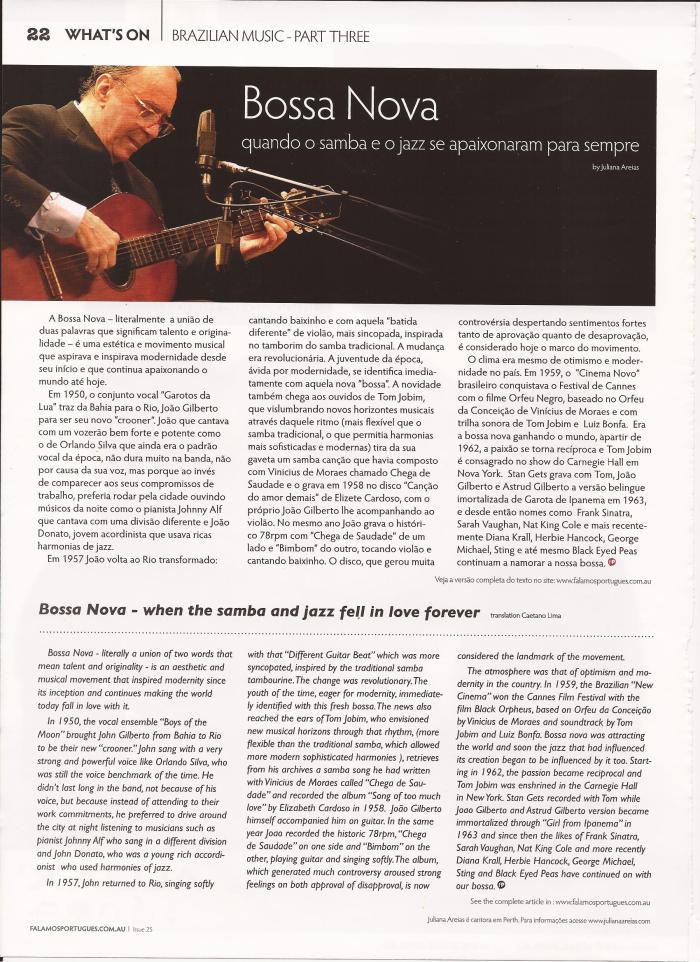Brazilian Music – Part three – Bossa Nova – February 2011 – Issue 25
BRAZILIAN MUSIC PART 3 – Bossa Nova – When samba and jazz fell in love forever

Bossa Nova – literally means talent and originality – it is an aesthetic and musical movement that has aspired and inspired modernity since its conception and continues to make the modern world fall in love with it.
Influenced by the Jazz recordings that arrived in Brazil after the 2nd World War, Brazilian singer Dick Farney (known as the Brazilian Sinatra) recorded “Copacabana” in 1946. This song was one of the Bossa Nova’s precursors.
In 1950, the vocal ensemble “ Garotos da Lua” (Moon’s boys) brought Joao Gilberto from Bahia to Rio to be their new crooner. Joao had a very strong and powerful voice, like, “Orlando Silva”, who was still the standard voice of the time. However, Joao didn’t last long in the band, not because of his vocal ability, but because instead of attending to the band’s commitments, he preferred to go the legendary “Beco das Garrafas” ( Bottles Lane) and other places around the city at night listening to musicians such as: pianist Johnny Alf ‘s different rhythmic division and the young accordionist/ pianist Joao Donato’s rich jazz harmonies.
Before leaving Rio, Joao also shared a flat with “Lucio Alves”, a “cool style” singer who recorded with Dick Farney the song “ Teresa da Praia” ( Teresa from the beach) composed by Antonio Carlos Jobim and Billy Blanco in 1954. This song was Jobim’s first hit. Teresa was the name of Jobim’s first wife. In the song the two singers are rivals competing to be Teresa’s favourite lover. The song was a clever marketing analogy since in real life; there was rivalry between Dick and Lucio’s fan clubs.
In 1957, Joao returned to Rio singing softly and playing with that “different guitar beat” which was more syncopated than the traditional samba, inspired by the beat pattern of the “tamborim” ( a samba hand percussion played with a stick, smaller and different from the tambourine). The change was revolutionary. The youth of the time, eager for modernity, immediately identified with this fresh “bossa”, organising jam session parties at their comfortable upper-middle class apartments to play the new style and share their new compositions. The Copacabana apartment of Nara Leao parents was the most famous meeting place for the young musicians and composers such as Carlos Lyra, Roberto Menescal and Ronaldo Boscoli.
The news also reached Jobim’s ears, who envisioned new musical horizons through that rhythm (a more flexible samba, which allowed more modern and sophisticated harmonies).
From his archives, Jobim retrieved a “samba cancao” song he had written with poet Vinicius de Moraes called “ Chega de Saudade” (No more blues) and recorded it for the album “Cancao do amor demais”(Song of too much love) by Elizeth Cardoso in 1958. Joao Gilberto himself accompanied her on guitar. In the same year, Joao recorded the historic 78rpm with “Chega de Saudade” on one side and “Bimbom” on the other, playing guitar and singing softly. This album, which generated much controversy and aroused strong feelings of both approval and disapproval is now considered the landmark of the Bossa Nova Movement.
The Bossa Nova reflected the atmosphere of optimism and modernism of the country. The Brazilian President Juscelino Kubitschek – known as the Bossa Nova President – commissioned Brazilian architect, Oscar Niemeyer, to create
“Brasilia” the new capital of Brazil to be one of the most modern cities of the world. In 1958, Brazil won its first World Cup with the legendary players Pele and Garricha in its team. In 1959, the “Brazilian New Cinema” (“Cinema Novo”) won the Cannes Film Festival with the film Black Orpheus, based on “Orfeu da Conceicao” by Vinicius de Moraes and soundtrack by Antonio Carlos Jobim and Luiz Bonfa. Bossa nova was attracting the world’s attention and soon the jazz which had influenced its creation began to be influenced by it in turn.
The passion became clearly reciprocal from 1962 when Antonio Carlos Jobim was acclaimed at the Carnegie Hall in New York. Stan Gets recorded with Jobim, Joao Gilberto and Astrud Gilberto, the immortalized version of “The girl from Ipanema” in 1963 and since then celebrities such as Frank Sinatra, Sarah Vaughan, Nat King Cole and more recently Diana Krall, Herbie Hancock, George Michael, Sting and Black Eyed Peas have continued on “dating” our bossa.